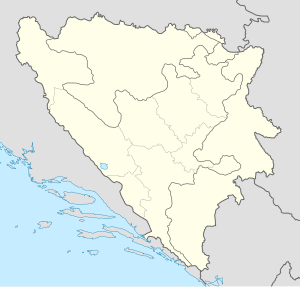|
Defense of Foča
The Battle of Foča took place from April 8 to 17 in 1992,[1][2] when Bosnian Serbs and Serb volunteers from Montenegro invaded Foča and fought with the Territorial Defence Force of the Republic of Bosnia and Herzegovina (TORBIH). It was the site of one of the first battles in this war, along with the Siege of Sarajevo, Operation Višegrad, the Battle of Zvornik and the Battle of Kupres. Located 20 km southwest of Goražde, Foča is located on an important strategic road that leads from north to south through the entire Drina valley. There were major escalations of inter-ethnic contradictions here, as well as throughout Bosnia in March. After a series of incidents, on March 23, the SDS local crisis headquarters announced a "state of readiness". This step was primarily caused by the news about the growing pressure on the Serbian minority in Goražde.[3]
Strength of the partiesSerbian sideThe Police of Republika Srpska was formed on April 4 of 1992.[4] The Serbian forces in Foča and its surroundings consisted mainly of Territorial Defense fighters (about 1,000 people) including volunteer detachments from Montenegro and neighboring municipalities and 200 local policemen who recently joined the newly formed Bosnian Serb police. After that, in the last phase of the fight for the city, volunteers from the "Serbian Movement" Vojislav Šešelj joined. Limited support was provided by units of the 37th Užice Corps of the JNA.[5] Bosnian sideThe Bosnian forces in Foca numbered several hundred soldiers,[5] just under a thousand. They were the most organized and well-armed Bosnian forces in eastern Bosnia. Unlike Bijeljina, Zvornik and Višegrad, where the Serbs established their control in one or two days, the fighting for Foča lasted three weeks. Cours of the clashesWhen Bosnia and Herzegovina formally declared independence on April 6, on the same day the Serbs from Foča took control of the main municipal buildings, including the police service, and declared their affiliation to Bosnia and Herzegovina and their independence from the government in Sarajevo. The battles that started in the city, in the evening of April 8,[6][2] moved to the area of the hydroelectric plant on April 9, as well as in Zvornik, the Serbs issued an ultimatum: "Lay down your weapons!" The Bosnians ignored them, and in the evening of the same day, Serbian fighters began bombarding the city with howitzers. The fight was fought in the suburbs near the majority of the Bosnian population (Donji Polje, Aladža). In the next few days, Serbian fighters took over the suburbs of Foča. Here the Bosnian Muslims fought skillfully and desperately. Most of the city in the afternoon seems dead (many locals have already fled).[7] Complete control over Foča comes on April 14, when the Serbian forces manage to drive the Muslim snipers out of the skyscrapers (from which the Muslim snipers control the entire city) with concentrated artillery fire. After the fall of the settlement of Donje Polje, where the strongest resistance was offered, the Muslim defenses began to collapse, and by April 17, most of the Muslim forces had left the city, including a large part of the peaceful population.[8] The liberation of Foča was a great success for the Serbs in their Offensive in Podrinje, but they still had to contend with sabotage by several Muslim groups scattered throughout the city. Only at the end of July did Serbian fighters manage to fully secure this area. In the following days, two VRS tactical groups were formed in Visegrad and Foča. Which actively participated in the battles for the Trnovo - Goražde corridor (including "Lukavac '93"), which the Muslims were trying to establish. The fighting in Podrinje in 1992 spread to the triangle between Rogatica, Višegrad and Goražde, along both banks of the Drina.[9] The massacre in Gornja JošanicaThe Gornja Jošanica massacre was the mass murder in the village of Gornja Jošanica, near Foča in eastern Bosnia, where 56 Bosnian Serb civilians were killed during an attack by the Army of the Republic of Bosnia and Herzegovina (ARBiH) from 19 December 1992, on St. Nicolas Day.[10] On 19 December 1992, Bosniak soldiers attacked the village of Gornja Jošanica, where about 600 members of the ARBiH took part in the attack, in ten groups deployed to ten other Jošanica hamlets, which were wiped out.[10] References
|
||||||||||||||||||||||||||||||||

